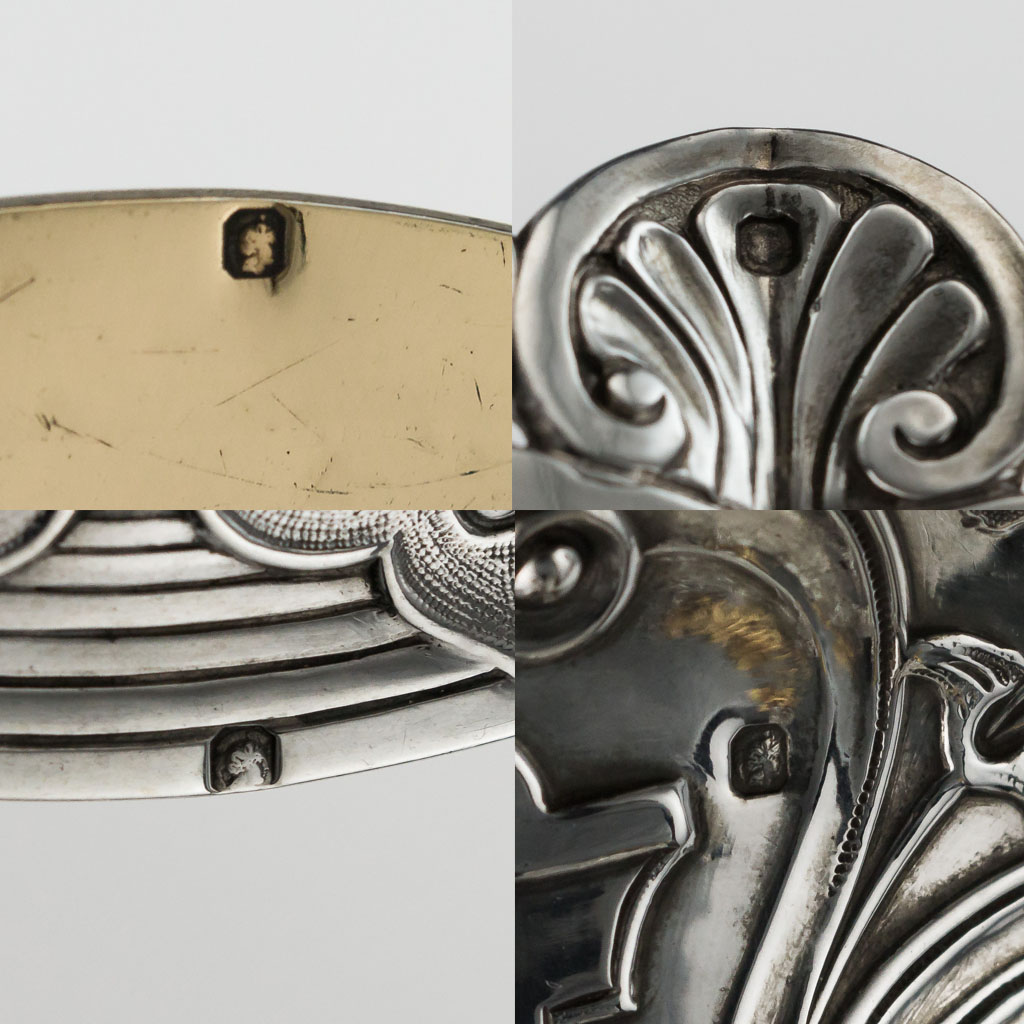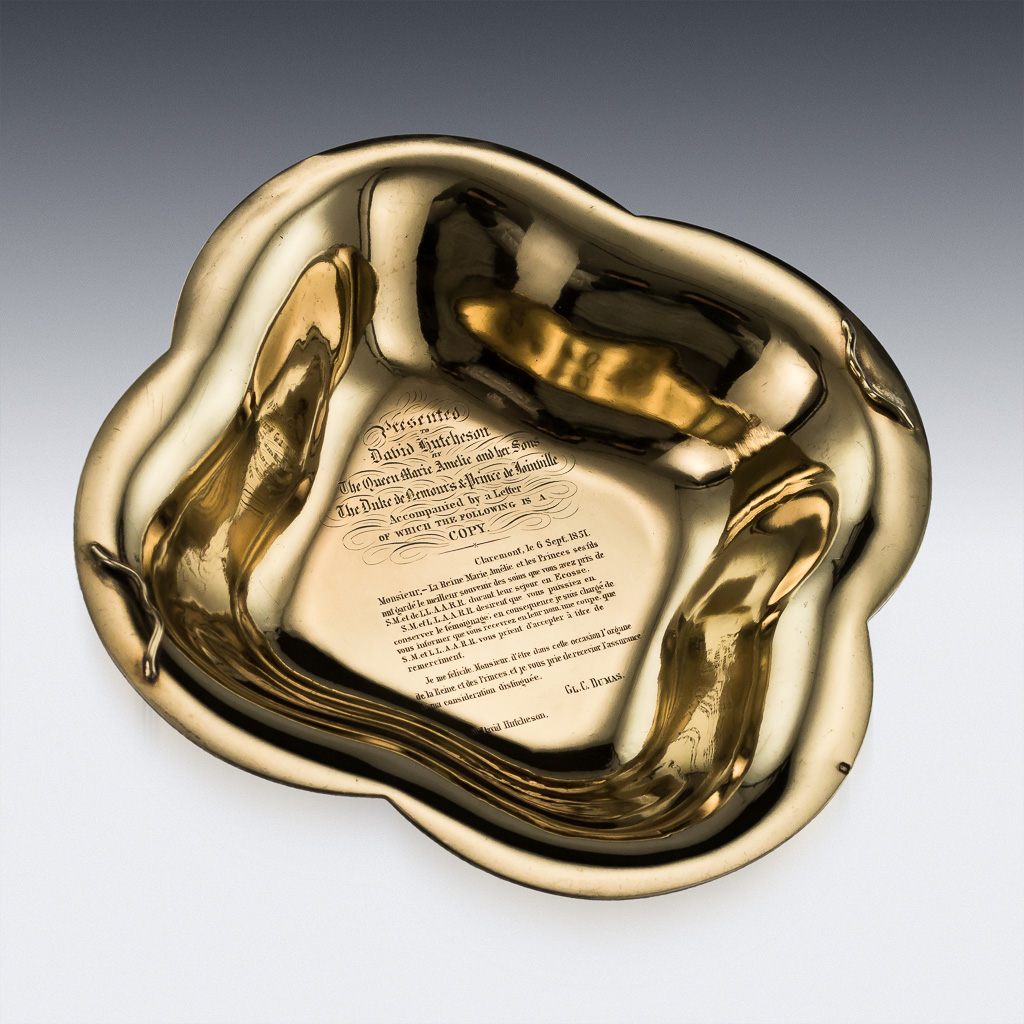 Image 1 of 22
Image 1 of 22

 Image 2 of 22
Image 2 of 22

 Image 3 of 22
Image 3 of 22

 Image 4 of 22
Image 4 of 22

 Image 5 of 22
Image 5 of 22

 Image 6 of 22
Image 6 of 22

 Image 7 of 22
Image 7 of 22

 Image 8 of 22
Image 8 of 22

 Image 9 of 22
Image 9 of 22

 Image 10 of 22
Image 10 of 22

 Image 11 of 22
Image 11 of 22

 Image 12 of 22
Image 12 of 22

 Image 13 of 22
Image 13 of 22

 Image 14 of 22
Image 14 of 22

 Image 15 of 22
Image 15 of 22

 Image 16 of 22
Image 16 of 22

 Image 17 of 22
Image 17 of 22

 Image 18 of 22
Image 18 of 22

 Image 19 of 22
Image 19 of 22

 Image 20 of 22
Image 20 of 22

 Image 21 of 22
Image 21 of 22

 Image 22 of 22
Image 22 of 22























ANTIQUE 19thC ODIOT SOLID SILVER GILT ROYAL PRESENTATION VASE, PARIS c.1845
19th Century French silver figural vase & cover, of quatrefoil form, the base and handles mounted with cast cherubs and the surfaces richly chased with masks, arabesques and other motifs, equestrian group finial, the gilt interiors of the liner and cover engraved with important French and English inscriptions. Hallmarked French silver (Minerva's head, 950), Paris, year 1845, Maker's mark for Maison Odiot.
Reference Number: A4361
19th Century French silver figural vase & cover, of quatrefoil form, the base and handles mounted with cast cherubs and the surfaces richly chased with masks, arabesques and other motifs, equestrian group finial, the gilt interiors of the liner and cover engraved with important French and English inscriptions. Hallmarked French silver (Minerva's head, 950), Paris, year 1845, Maker's mark for Maison Odiot.
Reference Number: A4361
19th Century French silver figural vase & cover, of quatrefoil form, the base and handles mounted with cast cherubs and the surfaces richly chased with masks, arabesques and other motifs, equestrian group finial, the gilt interiors of the liner and cover engraved with important French and English inscriptions. Hallmarked French silver (Minerva's head, 950), Paris, year 1845, Maker's mark for Maison Odiot.
Reference Number: A4361
DESCRIPTION
Antique 19th Century unique and exceptionally rare French solid silver figural vase & cover, of quatrefoil form, the base and handles mounted with cast cherubs and the surfaces richly chased with masks, arabesques and other motifs, equestrian group finial, the gilt interiors of the liner and cover engraved with important French and English inscriptions.
All parts hallmarked French silver (Minerva's head, 950 high standard), Paris, year 1845, Maker's mark for Maison Odiot, and further signed ODIOT APARIS".
Maison Odiot is considered the best French silversmith of his generation and is the successor of the famous dynasty of French silversmiths. His father was Jean-Baptiste-Coude Odiot, Napoleon's silversmith and the firm produced exhibition pieces for all the 19th century World Exhibitions and the most important Royal families of the world, such as the Tsars of Russia, Maximilian I Joseph of Bavaria, Said Pacha, Viceroy of Egypt.
The presentation was widely reported in the Press:
‘PRESENTATION TO DAVID HUTCHESON, ESQ., BY THE EX-ROYAL FAMILY OF FRANCE.
‘We are happy to learn that Mr. David Hutcheson, the able managing partner of the Highland Steam-boat Company, has just been presented by the ex-Royal family of France with a handsome and very valuable silver vase, ornamented with gilt figures, in acknowledgement of the courtesy and attention which that gentleman paid to the Royal exiles during their late tour through the western Highlands. The vase consists of a plateau, with a cup, or plate, supported on a pillar of silver richly chased. The corners of the plateau consist of beautiful and massive gilt figures in filigree work; the handles of the vase are ornamented in a similar manner, and the cover is surmounted by a beautifully executed rearing horse in gild silver, forming one of the most massive and beautiful table ornaments which we have ever seen. The workmanship is by the celebrated Odiot of Paris. There is no inscription upon this very valuable present; but we understand it is the intention of Mr. Hutcheson to have the following graceful letter, which accompanied the gift, engraved in the inside of the plate. . . .’
(The Glasgow Herald, Monday, 15 September 1851, p. 5b)
The inscription on the interior of the liner reads as follows:
‘Presented to David Hutcheson by The Queen Marie Amelie and her Sons The Duke de Nemours & Prince de Joinville Accompanied by a Letter of which the following is a COPY
‘Claremont, le 6 Sept. 1851.
‘Monsieur, - La Reine Marie Amélie et les Princes ses fils ont gardé le meilleur souvenir des soins que vois avez pris de S.M. et de L.L.A.A.R.R. Durant leur sejour in Ecosse.
‘S.M. et L.L.A.A.R.R. desirent que vous puissiez en conserver le témoignage; en consequence, je suis chargé de vous informer que vous recevrez en leur nom, une coupe, que S.M. et L.L.A.A.R.R. vous priet d’accepter à titre de remerciment.
‘Je me felicite, Monsieur, d’être dans cette occasion l’organe de la Reine et des Princes, et je vous prie de recevoir l’assurance de ma consideration distinguée.
‘Gl. C. DUMAS.’
In addition an inscription on the interior of the cover reads as follows:
‘The following is a Copy of a Letter accompanying a Gold Mounted Pencil Case with the word "Souvenir"engraved on the Stone. Received by David Hutcheson on the Part of the Duchess d’Orleans, Whom, with her two Sons The Count de Paris & Duke de Chartres He had the Honor of conducting through the Highlands of Scotland in July 1851, in the suite of Her Royal Highness were The Count & Countess de Ségur, and other distinguished Personages.
‘COPY
‘Edinbourg 22 Juillet 1851.
‘Monsieur
‘Son altesse Royale, Madame la Duchesse d’Orleans, me Charge de vous offrir de Sa part un porte, Crayon, qu’elle vous prie d’accepter Comme un marque de Sa reconnaissance pour vos bous Soins et un Souvenir de Son passage en Ecosse.
‘Veiullez Monsie
ur, recevoir l’expression de mes Sentimens distingnés.
‘Mise. De Pins Peysae.’
Marie Amelie, Queen of the French, otherwise Duchess d’Orléans, was born Maria Amalia of Naples and Sicily on 26 April 1782. The seventh child of Ferdinand I of the Two Scillies and his wife, Maria Carolina of Austria, she married in 1809 Louis Philippe, Duke of Orléans (1773-1850). Following the July Revolution of 1830 in France, the Duke was declared King of the French in succession to his deposed cousin, Charles X (1757-1836). Marie Amelie, at first reluctantly Queen of the French, is said to have considered her husband’s acceptance of the crown a catastrophe. She eventually warmed to the role, but before long political and social problems across Europe concluded in the Revolution of 1848. Louis Philippe was forced to abdicate and he, Marie Amelie and their surviving children left for England where Queen Victoria arranged for them to live at Claremont House, near Esher some 16 miles south west of London.
CONDITION
In Excellent Condition - no damage.
SIZE
Height: 38cm
Width: 32 x 25cm
Weight: 3115g





